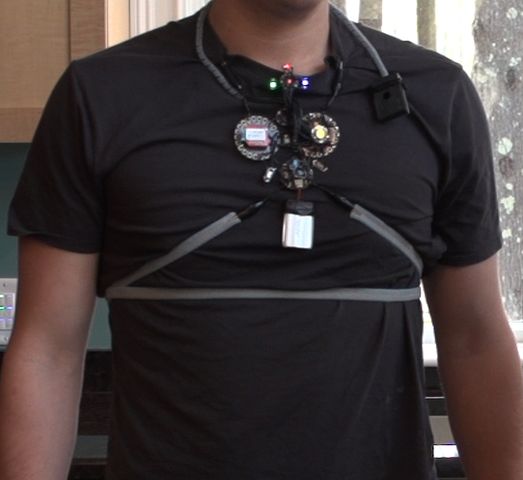Smart Clothes—A Wearable Air Quality Sensor
Posted on by Dr. Francis Collins
America is waking up to the importance of a healthy lifestyle. But while what you eat is important, what you breathe in matters, too. As you’re biking, running, or walking in the city—or anywhere for that matter—you’re inhaling car exhaust and other air pollution. Have you ever wondered how many lung-irritating particles you’re inhaling? And what effect air quality has on your health?
To address these questions, NIH, with the Department of Health and Human Services (our parent agency) and the Environmental Protection Agency, issued a challenge: the “My Air, My Health” challenge.
Applicants designed wearable, real-time, location-specific air pollution sensors that measure and link to an individual’s physiological data—including how deep your breathing is—and then transmit the info to a central data repository.

Caption: Close-up of the sensor. Developed by David Kuller (AUX), Gabrielle Savage Dockterman (Angel Devil Productions), and Dot Kelly (Shearwater Design).
Credit: Angel Devil Productions
Conscious Clothing, the group that created the sensor you see in the pictures, won the $100,000 grand prize—which was presented to them at the recent Health Datapalooza here in Washington, D.C. Their device is a very cool gizmo that allows you to track your breathing and the quality of the air around you. It also enables researchers to assess the presence of various airborne pollutants in real time—and determine their impact on health.
Links:
Conscious Clothing: watch the demo of the prototype
NIH support: National Institute of Environmental Health Sciences



A very bad idea. Shame on the NIH director, the EPA and the NIH in awarding the prize to this invention and the inventor for not considering the health effects of the electromagnetic radiation upon the wearer’s body.
I disagree to the first comment, there are plenty of products that release electromagnetic radiation, when it is low frequency and low power it has no long term or short effects to the body. It is like the big cell phone scare, “If you use your cell phone, you’ll get brain cancer”. Wrong everyone uses a cellphone, more than ever. The more they advance this prototype the better it will be and the lives will be saved. I’m also pretty sure that they would not have awarded this invention without considering the effects to people’s health.
More on the winners here!
http://blog.epa.gov/science/2013/06/visualizing-the-invisible-with-the-my-air-my-health-challenge-winners/
Personally I don’t like the idea of this project. I think there were better projects that merit of winning that prize.
This all seems quite irrelevant when public places allow smoking which, whilst on vacation to Philadelphia from England I noticed the adverse affect on my COPD as an innocent sufferer of Alpha 1 Anti-Trypstin after stopping for a drink in a bar. If I worn any special clothing to detect poor air it would have been off the scale. Educate people that smoking in other peoples airspace compromises unwilling participants.
It should be useless nowadays…Especially in the big cities
Amazing work!